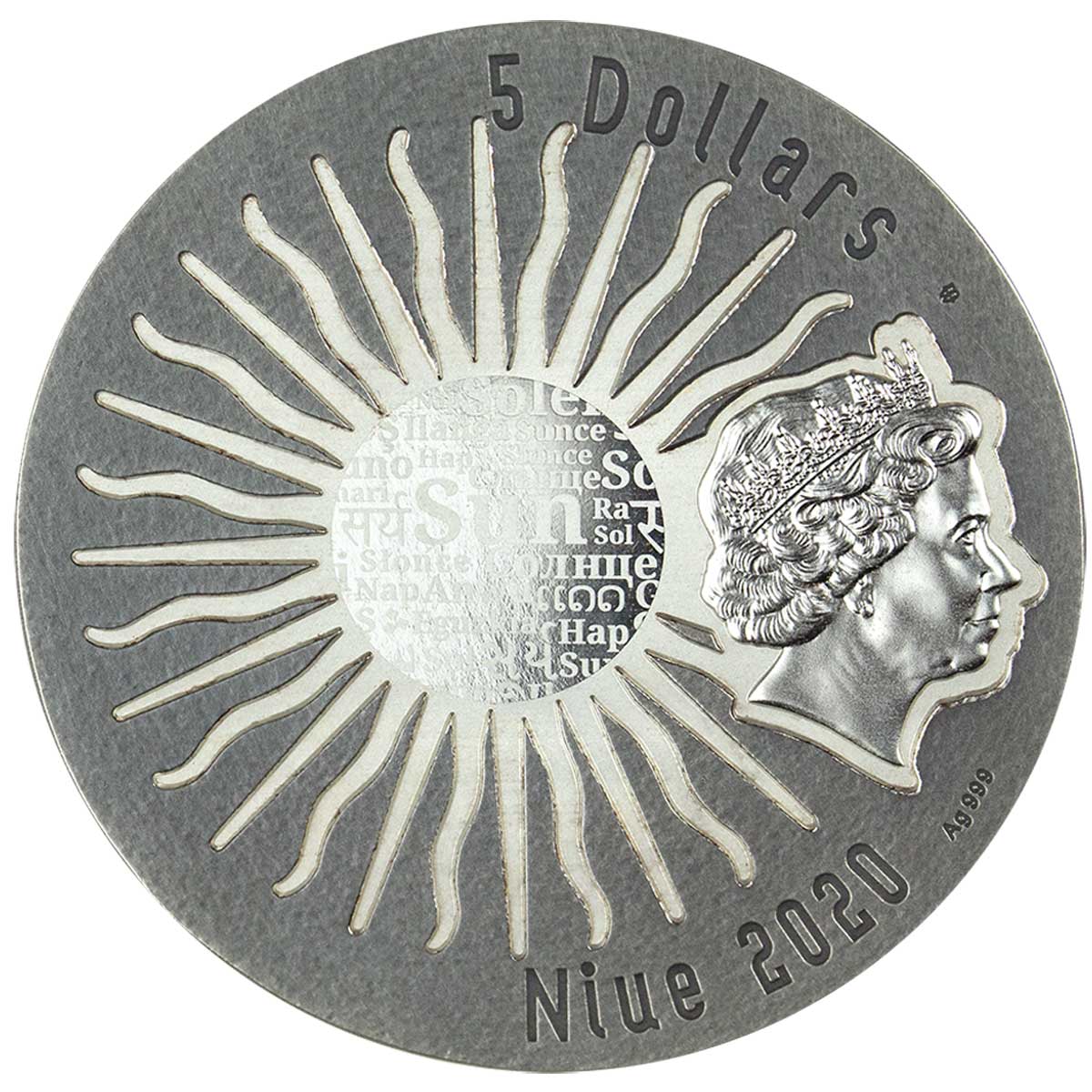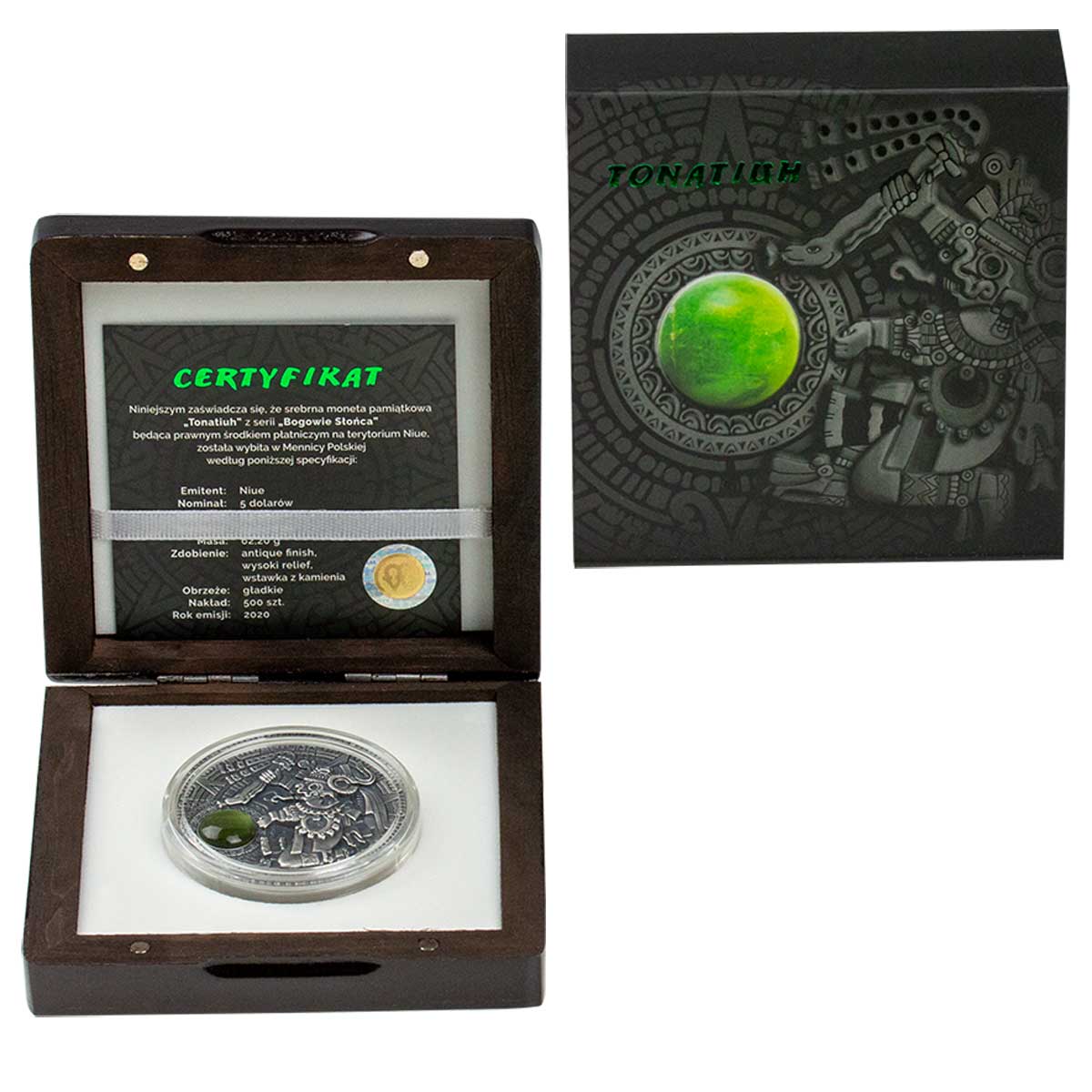Despite a seemingly endless wave of ancient history coins from the Mint of Poland, it’s become apparent that the imagination of those old civilisations was even greater. The mint continues to work its way through the myriad deities brought to life in those times, and has now turned its attention to the fascinating Mesoamerican world of the Aztecs.
The first issue in a series called simply ‘Sun Gods’ this latest coin depicts the Aztec god ‘Tonatiuh’. Depicted in that brilliant style that has become so synonymous with the region in the medieval period, he is brought to life in high-relief and with an antique finish. Inset into the reverse face is a polished half-sphere of olivine, the tough, green-tinged igneous mineral that is so abundant in the Earth’s crust. Only a less than perfect choice of font for the name is to the detriment of this symbolic, rather than realistic portrayal.
The obverse is another Niue one, combining the effigy of Queen Elizabeth II, but incorporated into a wider design. The solar symbol, filled with the word ‘Sun’ in many languages is neat enough, although not one of the mints best. Again, the choice of font for the inscriptions is one we think is less than optimal.
At two-ounces of fine silver in weight, this one ticks the boxes in a very popular genre, and it keeps the common 45mm diameter and 500 mintage. Boxed with a Certificate Of Authenticity, It’s being issued directly by the mint rather than through a third party distributor, and should ship in a few weeks time. A nice addition to the market and for a civilisation that is gaining in popularity for its distinctive style.
As an aside, we’re sure you’re as fascinated as I was about the image used above. It’s a sacrificial flint-bladed knife from the collection of the British Museum (© Trustees of the British Museum). It’s 32.3cm in length and has a handle carved from cedro wood. This was then covered in a mosaic made of turquoise, malachite and three types of shell, all stuck on with pine resin, to form a crouching eagle warrior. A macabre, if quite exquisite object that dates from somewhere in the period of 1400-1521.
TONATIUH AND THE AZTEC CREATION MYTH
The Aztecs believed that the cosmos had already gone through four stages, each with its own sun and beings. The present era for the Aztecs was that of the 5th and final sun, Tonatiuh. The god had been born from the sacrifice of Nanahuatzin who threw himself into a fire at Teotihuacan and thus became the new sun. There was an immediate problem that Tonatiuh could or would not set himself in motion across the sky without a blood sacrifice.
Now stepped in Tlahuizcalpantecuhtli, for the Aztecs the planet Venus as the menacing morning star. He angrily threw his atl-atl dart at Tonatiuh in order to set him on his orbit, but the sun retaliated by throwing a dart right back. This missile hit Tlahuizcalpantecuhtli right in the forehead, instantly transforming him into stone and the god Itztlacoliuhqui, a deity associated with ice and cold. The rest of the gods realised that only a sacrifice would set the sun in motion and so Quetzalcoatl removed their hearts for that purpose. The offering worked and Tonatiuh was on his way.
Tlahuizcalpantecuhtli had not left the scene permanently, though, and every 584 days he rises from the eastern sea to do battle with Tonatiuh once again. For this reason, Tonatiuh had to be strengthened via the sacrifice of humans so that he could feast on their hearts, just as he had first been nourished by the hearts of the gods. It was imagined that the sun was swallowed each night by the earth-fertility goddess, Tlaltecuhtli, and then regurgitated by the toad-like monster the following morning. Sacrifices ensured his successful return and victory each night against her and the forces of darkness.
Warriors were closely associated with Tonatiuh because it was their duty to ensure a steady supply of sacrificial victims for him. The spirits of dead warriors, too, were conducted to the next life by Tonatiuh. In addition, given the sun’s vital role in ensuring the well-being of the cosmos and the Aztec ruler’s position as chief warrior, Tonatiuh had his own sacrificial altar during coronation ceremonies. In times of great strife such as famine, droughts, and war, Tonatiuh could receive the huge number of bloody sacrifices that the Aztecs have become infamous forever since.
Cartwright, Mark. “Tonatiuh.” Ancient History Encyclopedia. Last modified March 30, 2017. https://www.ancient.eu/Tonatiuh/
| SPECIFICATION | |
| DENOMINATION | $5 NZD (Niue) |
| COMPOSITION | 0.999 silver |
| WEIGHT | 62.2 grams |
| DIMENSIONS | 45.0 mm |
| FINISH | Antique |
| MODIFICATIONS | High-relief, inset olivine stone |
| MINTAGE | 500 |
| BOX / C.O.A. | Yes / Yes |






There is the copy of Mint21 series?
How many of these will be released in this Sun God series?
Unknown at present. I’d imagine that popularity of the first one or two issues will have a bearing on the size of the set.